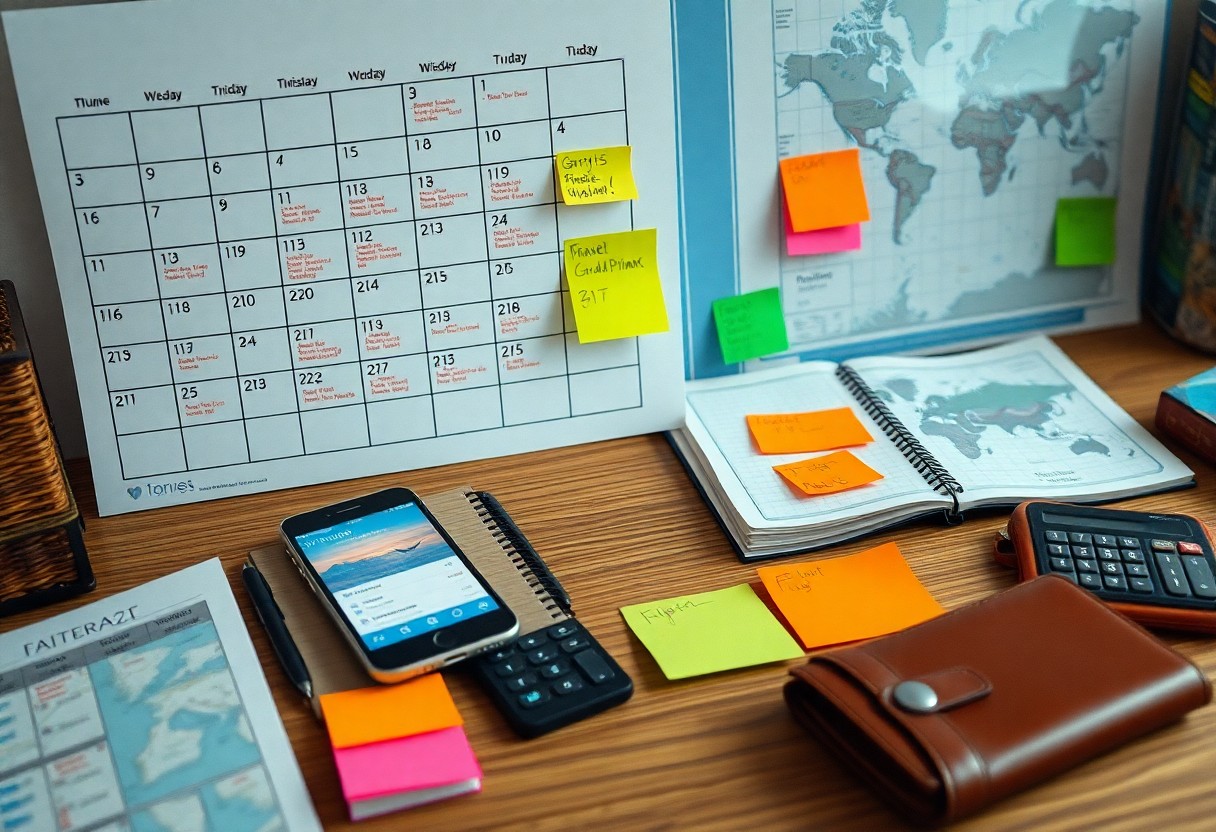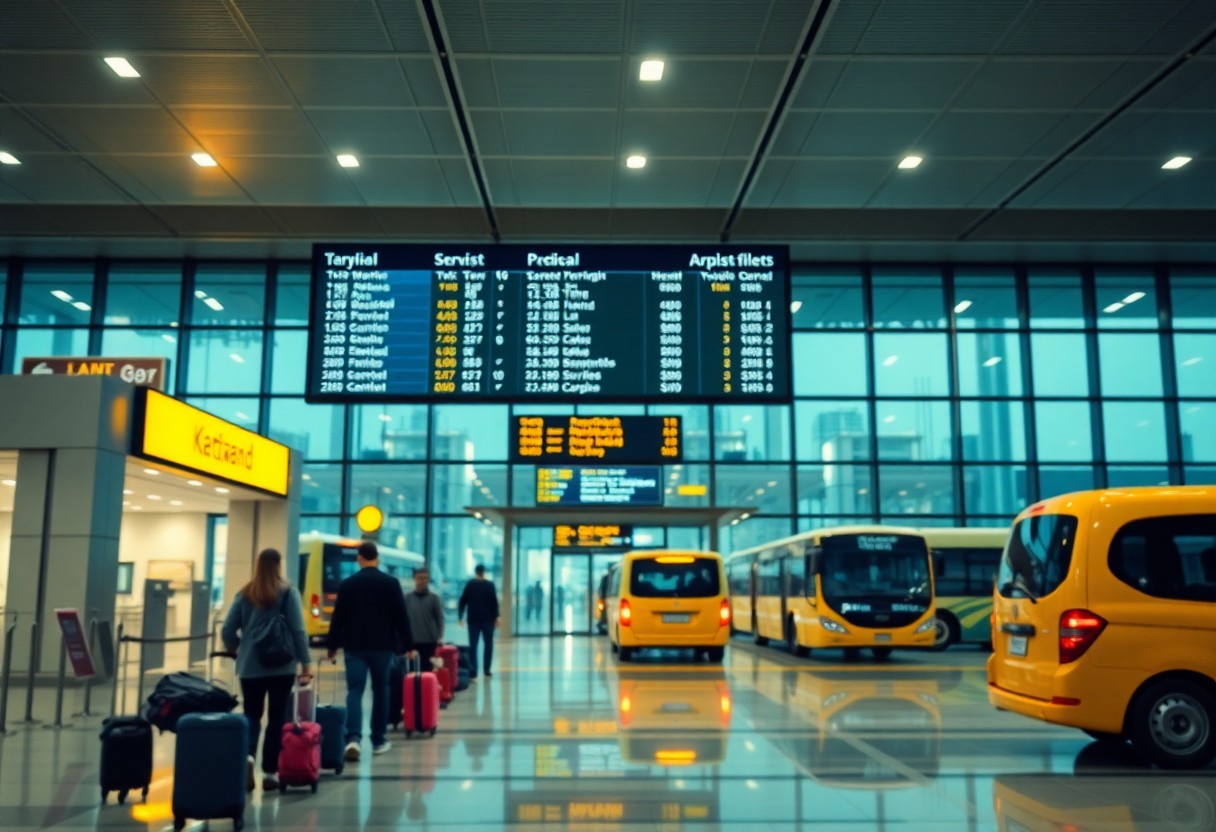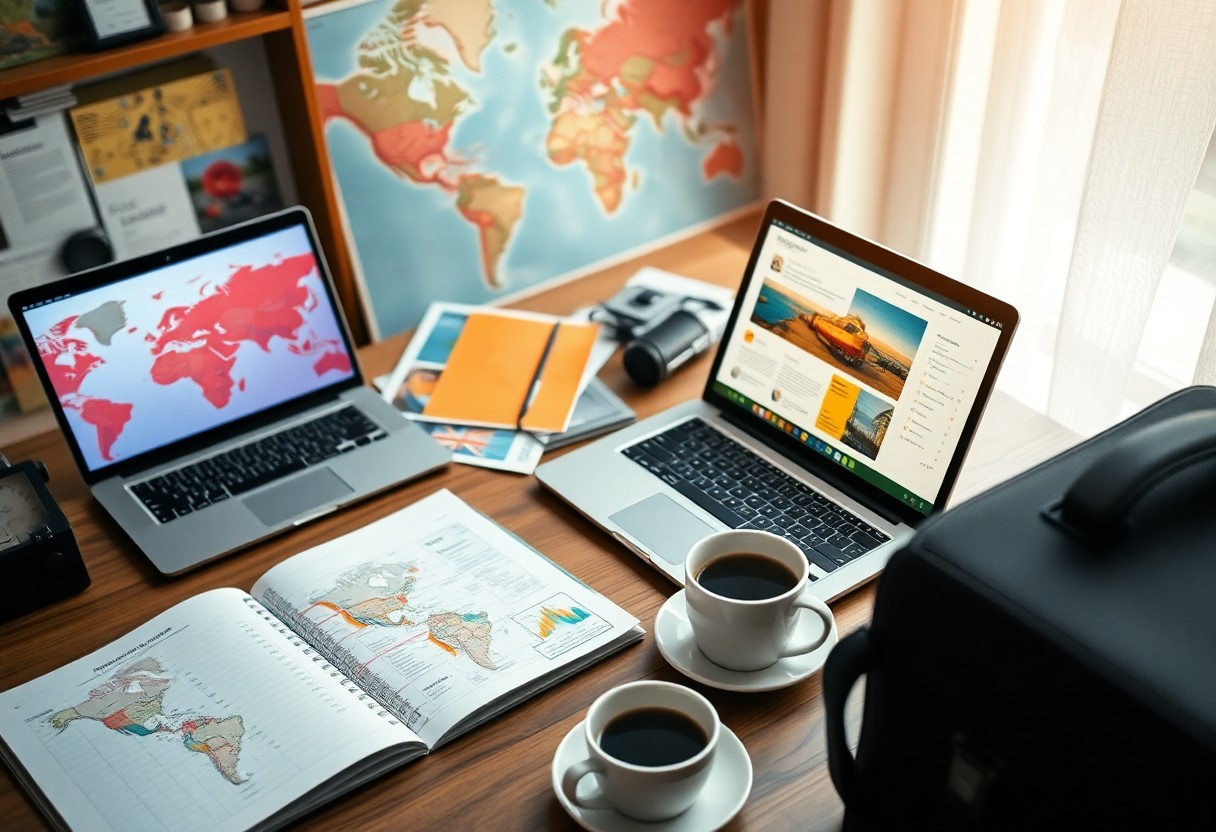You have the power to transform your travel planning experience into a smooth and enjoyable journey. This ultimate guide will equip you with vital tips and strategies that will help you navigate the often overwhelming process of organizing your trips. From setting a budget to creating a detailed itinerary, you’ll learn how to minimize stress and maximize your enjoyment at every step. Let’s get started on making your travel dreams a reality!
Crafting the Perfect Itinerary
Creating an itinerary isn’t just about filling in time slots; it’s about crafting a memorable experience that flows effortlessly. Start by identifying your travel goals, whether it’s relaxation, exploration, or cultural immersion. From there, distribute activities evenly throughout your days, leaving room for rest and spontaneity. Use apps or spreadsheets to keep everything organized, ensuring you have vital details like opening hours and ticket information readily available. A well-balanced itinerary enhances your trip, providing structure while allowing flexibility for unexpected adventures.
Balancing Must-Sees with Serendipitous Discoveries
While iconic landmarks should definitely make your itinerary, allow space for spontaneous discoveries that often become the highlights of your trip. Most cities have hidden gems just waiting to be explored—think local cafes, street markets, or public parks. Block out some time that’s unplanned, enabling you to wander and explore atmospheres at your leisure. Seek out recommendations from locals or enthusiasts; their insights may lead you to unique experiences that you won’t find in travel guidebooks.
Prioritizing Activities: The Art of Choosing Experiences
Being selective about activities is an art that can enhance your travel experience immeasurably. Start by categorizing what excites you the most—history, cuisine, nature, or shopping. Research shows that travelers who focus on quality over quantity report higher satisfaction levels. Instead of cramming in too many activities, choose a few that truly resonate and allow for a deeper connection, whether it’s taking a cooking class or visiting a lesser-known museum. Striking this balance ensures you can explore each experience without feeling rushed.
To prioritize effectively, identify what truly sparks your interest and aligns with your travel goals. Consider jotting down a “wish list” of experiences, separating them into “must-do” and “nice-to-have” categories. This approach not only makes decision-making easier but helps manage time effectively throughout the trip. Engage with online communities or social media groups related to your destination to gain insights into unique activities that might not be mainstream attractions. Ultimately, it’s about building a personalized itinerary that reflects your interests while still allowing room for spontaneity and exploration.

Budgeting Without the Stress
Planning a budget doesn’t have to feel overwhelming. Start by establishing a clear framework based on your travel goals. Prioritize your must-haves versus nice-to-haves, and stay realistic about costs. Factor in everything from flights and accommodations to daily meals and activities. This organized approach helps you keep your finances in check while enhancing your travel experience.
Cost Breakdown: Essential Expenses and Hidden Fees
Understanding your travel expenses requires a careful breakdown of both visible and hidden costs. Major categories include flights, accommodations, meals, transport, activities, and insurance. Don’t overlook those sneaky fees often associated with luggage, resort services, or local tourism taxes. A comprehensive cost assessment helps you avoid unwelcome surprises and ensures your budget aligns with your travel ambitions.
Savings Strategies: How to Maximize Your Travel Budget
Maximizing your travel budget hinges on effective savings strategies. Utilize fare comparison websites to find the best flight deals, and be flexible with your travel dates to take advantage of lower rates. Consider booking accommodations like vacation rentals or hostels, which often provide more cost-effective options than hotels. Participating in loyalty programs can also yield significant savings over time.
Using reward points from travel credit cards is another savvy approach; you could score free flights or hotel stays. For dining, enjoy local street food or visit markets instead of pricy restaurants – this can save you plenty while providing authentic culinary experiences. By combining these strategies, you can stretch your travel budget further, allowing you to enjoy more of what your destination has to offer without breaking the bank.

Seamless Logistics and Transportation
Effective travel planning hinges on seamless logistics and efficient transportation. Ensuring you have reliable connections and the right modes of transport lined up will make your journey a breeze. From booking flights and trains to arranging local transit, every detail matters. Double-checking schedules, account for potential delays, and considering alternate routes can save you hours of stress and keep your travel plans intact.
Choosing the Right Mode of Transport for Your Journey
Selecting the appropriate transportation for your trip can enhance your overall experience. Factors to consider include distance, destination, and your personal preferences. For short distances, local trains, buses, or even walking may be more efficient and enjoyable, while longer distances might necessitate flights or car rentals to maximize your time.
Packing Smart: Essentials vs. Luxuries
Balancing crucials and luxuries in your packing can significantly impact your travel comfort. Focus on items that meet your basic needs while leaving luxury items behind, allowing you to travel lighter and with more ease. Consider versatile clothing, important travel documents, and your favorite snacks as crucials, avoiding excess baggage.
Evaluating your packing list requires a pragmatic approach. Essentials cover items like toiletries, medications, chargers, and a few versatile clothing options. Luxuries, like extra pairs of shoes or excessive makeup, can often be left at home to save space. A good rule of thumb is to pack no more than twenty percent of your belongings with luxuries, ensuring you have what you need while maintaining the freedom to enjoy your adventure without being bogged down by unnecessary items. Keep in mind that many items can be easily purchased during your travels, so only bring what you can’t do without.

Embracing Flexibility and Adaptation
Travel rarely goes exactly as planned, so nurturing a mindset centered on flexibility can turn potential frustrations into opportunities for adventure. Allow for spontaneity in your schedule; unexpected detours may lead to unexpected discoveries, whether it’s a charming café that wasn’t on your radar or a local festival that enhances your experience. By maintaining a balanced itinerary, you ensure there’s room for both planned activities and last-minute changes, allowing you to embrace every moment fully.
Situations may arise that force you to alter your plans, from flight delays to sudden weather shifts. Having a backup plan in place means you can smoothly pivot without losing your travel rhythm. Identify alternative destinations, activities, or accommodations in advance so you can seamlessly transition without feeling overwhelmed. By keeping a few options up your sleeve, you will enhance your travel experience instead of allowing setbacks to derail your excitement.
Leveraging Technology: Apps and Tools for Effortless Management
Utilizing the right technology can significantly streamline your travel planning process. From itinerary management apps like TripIt to navigation tools such as Google Maps, technology simplifies your experience and keeps you organized. Many travel apps now offer real-time updates and alerts, helping you stay informed about changes to flights or local events. You can also use platforms such as Airbnb and Booking.com for instant accommodation insights, ensuring you can adapt your plans on the go with just a few taps.
Apps like Rome2rio allow you to discover multiple transportation options between destinations, showing bus, train, and flight schedules all in one place. For budgeting, consider using Trail Wallet, an expense tracker designed specifically for travelers; it helps you monitor your spending to avoid budget overruns while on the road. Each tool you integrate into your planning process makes it easier to adapt to unforeseen circumstances, ensuring that technology enhances your travels rather than complicates them.
Mental Preparation for Travel
Your mindset plays a significant role in experiencing a successful trip. By mentally preparing yourself for the journey ahead, you gear up for the unexpected and ensure your travels are as smooth as possible. Fostering a positive outlook can make all the difference in your approach to new experiences, enabling you to soak in the adventure, embrace challenges, and foster a sense of appreciation for what lies ahead.
Pre-Departure Mindset: Cultivating a Positive Outlook
Setting an optimistic mindset is imperative before you launch on your journey. Embrace anticipation and excitement by visualizing the experiences you’ll gain and the memories you’ll create. Journaling your travel aspirations can help clarify your intentions, and sharing your plans with friends or family can amplify the excitement, reinforcing your eagerness to explore. This positive outlook will elevate your travel experience and boost your resilience against any bumps in the road.
Overcoming Travel Anxiety: Techniques and Tips
Travel anxiety can dampen your adventure, but several techniques can help you manage those nagging worries. Recognizing triggering situations allows you to tackle them head-on. Breathing exercises, visualization techniques, and grounding activities can help center your thoughts and ease tension. Building a pre-travel routine filled with relaxation techniques often leads to a calmer experience, even before you leave home.
- Practice deep breathing or meditation to calm your nerves before traveling.
- Rehearse your itinerary to familiarize yourself with your travel plans.
- Establish a routine and organize your packing ahead of time.
- Perceiving travel as an opportunity for growth can minimize anxiety.
Incorporating grounding exercises, such as focusing on your surroundings or engaging your senses, can quell anxiety spikes while traveling. Regular physical activity helps release stress, so getting a workout in before your trip might also serve you well. Consider keeping a journal to document your thoughts and feelings before, during, and after the trip, facilitating a deeper understanding of your travel anxiety. Perceiving travel not just as a relocation but as a personal journey can empower you to embrace the adventure with open arms.
- Maintain an open line of communication with loved ones for support during your travels.
- Prepare contingency plans for possible disruptions to ease worries.
- Utilize relaxation apps specifically designed for anxiety management.
- Perceiving the positives in travel can shift your mindset and combat nerves.
Final Words
Now that you have mastered the art of stress-free travel planning, you can begin on your adventures with confidence and ease. By following this ultimate guide, you’ve equipped yourself with the tools to streamline your itinerary, manage your budget, and stay organized. With thoughtful preparation and a positive mindset, you can ensure that your travels are enjoyable and fulfilling, allowing you to focus on making unforgettable memories. Get ready to explore the world, knowing that you have the skills to navigate any challenges that come your way.
Q: What are the imperative steps to take when planning a stress-free trip?
A: To ensure a smooth travel experience, start with defining your budget and destination. Next, research and choose accommodations that suit your preferences. Create an itinerary that incorporates activities and free time, allowing flexibility. Lastly, prepare important documents such as passports, visas, and bookings in advance to avoid last-minute scrambles.
A: To minimize travel stress, consider using a travel planning checklist to keep track of tasks and deadlines. Opt for flexible travel options, like refundable flights and accommodations. Additionally, be sure to have contingency plans in place, such as alternative activities or transportation options, in case unexpected situations arise.
Q: What tools or resources can assist in creating a seamless travel plan?
A: Utilize travel planning apps that offer itinerary management, budget tracking, and reservation alerts. Websites dedicated to travel reviews can provide insights into destinations, accommodations, and activities. Moreover, resources like packing lists and travel blogs can help streamline your preparations, making the planning process efficient and enjoyable.
